A) 1.42 cm
B) 1.66 cm
C) 1.93 cm
D) 2.19 cm
E) 2.38 cm
G) C) and D)
Correct Answer

verified
Correct Answer
verified
Multiple Choice
The figure is a scaled diagram of a an object and a converging lens.The focal length of the lens is 5.0 units.An object is placed 3.0 units from the lens as shown. 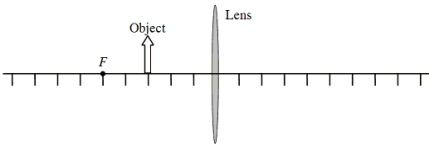 -The object has a height of 1.5 units.What is the approximate height of the image?
-The object has a height of 1.5 units.What is the approximate height of the image?
A) 2.0 units
B) 1.2 units
C) 5.0 units
D) 3.8 units
E) 9.8 units
G) B) and C)
Correct Answer

verified
Correct Answer
verified
Multiple Choice
When certain light rays pass from a vacuum into a block of an unknown material, the measured index of refraction of the material is 3.00.What is the speed of light inside the block?
A) 9.9 × 106 m/s
B) 4.8 × 107 m/s
C) 1.0 × 108 m/s
D) 1.9 × 108 m/s
E) 2.9 × 108 m/s
G) None of the above
Correct Answer

verified
Correct Answer
verified
Multiple Choice
A converging lens with a focal length of 12 cm produces a 3-cm high virtual image of a 1-cm high object.Which entry in the table below is correct? 
A) ![]()
B) ![]()
C) ![]()
D) ![]()
E) ![]()
G) A) and C)
Correct Answer

verified
Correct Answer
verified
Multiple Choice
Light that is incident upon the eye is refracted several times before it reaches the retina.As light passes through the eye, at which boundary does the majority of the overall refraction occur?
A) lens/aqueous humor
B) air/cornea
C) lens/vitreous humor
D) aqueous humor/iris
E) vitreous humor/retina
G) A) and D)
Correct Answer

verified
Correct Answer
verified
Multiple Choice
A child sitting at the edge of a swimming pool sees a coin resting on the bottom of the pool.The coin appears to be 0.75 m directly below the water's surface.How deep is the pool at the location of the coin? The index of refraction of water is 1.33.
A) 0.75 m
B) 0.86 m
C) 1.0 m
D) 1.2 m
E) 1.6 m
G) A) and E)
Correct Answer

verified
Correct Answer
verified
Multiple Choice
The moon is observed using a telescope that has an objective lens with a focal length of 3.0 m and an eyepiece with a focal length of 6.0 cm.What is the angular diameter of the moon if the earth-moon distance is 3.85 × 108 m and the diameter of the moon is 3.48 × 106 m?
A) 0.36 rad
B) 0.45 rad
C) 0.72 rad
D) 0.90 rad
E) 1.4 rad
G) A) and C)
Correct Answer

verified
Correct Answer
verified
Multiple Choice
The figure shows the path of a portion of a ray of light as it passes through three different materials. Note: The figure is drawn to scale. 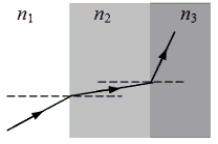 What can be concluded concerning the refractive indices of these three materials?
What can be concluded concerning the refractive indices of these three materials?
A) n1 < n2 < n3
B) n1 > n2 > n3
C) n3 < n1 < n2
D) n2 < n1 < n3
E) n1 < n3 < n2
G) C) and D)
Correct Answer

verified
Correct Answer
verified
Multiple Choice
A fiber optic line is composed of a core with an index of refraction of 1.51 and cladding with an index of 1.40.Which one of the following relations best describes angles of incidence that will result in total internal reflection within the fiber optic line?
A) ( < 68°)
B) ( > 68°)
C) ( < 22°)
D) ( > 22°)
E) (0 90°)
G) B) and C)
Correct Answer

verified
Correct Answer
verified
Multiple Choice
Which one of the following statements concerning the index of refraction for a given material is true?
A) The index of refraction may be less than 1.
B) The index of refraction may be measured in nanometers.
C) The index of refraction does not depend on the frequency of the incident light.
D) For a given frequency, the index of refraction is inversely proportional to the wavelength of light in vacuum.
E) For a given frequency, the index of refraction is inversely proportional to the wavelength of light in the material.
G) C) and E)
Correct Answer

verified
Correct Answer
verified
Multiple Choice
What is the frequency of light that has a wavelength in water of 788 nm if the refractive index for this light is 1.33?
A) 3.76 × 1014 Hz
B) 5.00 × 1014 Hz
C) 6.65 × 1014 Hz
D) 2.86 × 1014 Hz
E) 9.52 × 1014 Hz
G) A) and E)
Correct Answer

verified
Correct Answer
verified
Multiple Choice
A 4-cm object is placed in front of a converging lens of focal length 20 cm.The image is formed 60 cm on the other side of the lens.Which entry in the table below is correct? 
A) ![]()
B) ![]()
C) ![]()
D) ![]()
E) ![]()
G) C) and D)
Correct Answer

verified
Correct Answer
verified
Multiple Choice
A glass block with an index of refraction of 1.7 is immersed in an unknown liquid.A ray of light inside the block undergoes total internal reflection as shown in the figure.Which one of the following relations best indicates what may be concluded concerning the index of refraction of the liquid, nL? 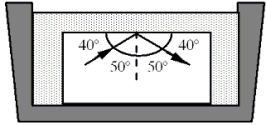
A) nL < 1.0
B) nL 1.1
C) nL 1.3
D) nL 1.1
E) nL 1.3
G) B) and E)
Correct Answer

verified
Correct Answer
verified
Multiple Choice
26-7
A 4.0-cm object is placed 30.0 cm from a converging lens that has a focal length of 10.0 cm as shown in the diagram.
Note: The diagram is not drawn to scale. 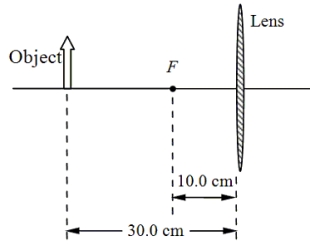 -Where is the image located?
-Where is the image located?
A) 15 cm to the left of the lens
B) 7.5 cm to the left of the lens
C) 7.5 cm to the right of the lens
D) 15 cm to the right of the lens
E) 30 cm to the right of the lens
G) A) and C)
Correct Answer

verified
Correct Answer
verified
Multiple Choice
A ray of light originates in medium A and is incident upon medium B.For which one of the following pairs of indices of refraction for A and B is total internal reflection not possible? 
A) ![]()
B) ![]()
C) ![]()
D) ![]()
E) ![]()
G) B) and D)
Correct Answer

verified
Correct Answer
verified
Multiple Choice
Light propagates from soda lime glass (n = 1.518) into Pyrex glass (n = 1.473) .Determine the critical angle for this situation.
A) 13.99°
B) 45.86°
C) 52.48°
D) 65.22°
E) 76.01°
G) C) and D)
Correct Answer

verified
Correct Answer
verified
Multiple Choice
26-13
A fish swims 4.0 m below the surface of a still lake as shown in the figure.When an archer attempts to shoot the fish, the arrow enters the water at point P that is a horizontal distance 1.2 m from the fish. 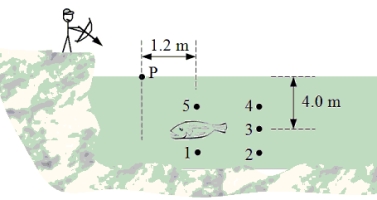 -If the archer is successful in shooting the fish, what angle does the arrow make with the horizontal as it enters the water?
-If the archer is successful in shooting the fish, what angle does the arrow make with the horizontal as it enters the water?
A) 12°
B) 17°
C) 23°
D) 67°
E) 73°
G) B) and D)
Correct Answer

verified
Correct Answer
verified
Multiple Choice
When an object is placed 25 cm from a lens, a real image is formed.Which one of the following conclusions is incorrect?
A) The image is upright.
B) The lens is a converging lens.
C) The image may be reduced or enlarged.
D) The image distance can be less than 25 cm.
E) The focal length of the lens is less than 25 cm.
G) A) and E)
Correct Answer

verified
Correct Answer
verified
Multiple Choice
A beam of light that consists of a mixture of red, green and violet light strikes a prism (surrounded by air) as shown.Indices of refraction for this prism for the various colors are indicated in the table.An observer is located to the right of the prism as shown. 
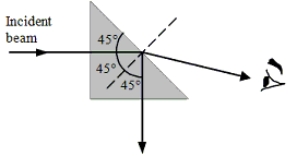 -Which one of the following statements is true concerning the focal length of a lens?
-Which one of the following statements is true concerning the focal length of a lens?
A) The focal length is the same for all colors.
B) The focal length is different for different colors because of reflection.
C) The focal length is different for different colors because of dispersion.
D) The focal length is different for different colors because of polarization.
E) The focal length is different for different colors because of spherical aberration.
G) A) and D)
Correct Answer

verified
Correct Answer
verified
Multiple Choice
A grizzly bear is sitting on a rock in the middle of a calm river when she observes a fish directly below.If the apparent depth of the fish is 0.40 m, what is the actual depth at which the fish is swimming? The index of refraction of water is 1.33.
A) 0.80 m
B) 0.71 m
C) 0.62 m
D) 0.53 m
E) 0.45 m
G) A) and D)
Correct Answer

verified
Correct Answer
verified
Showing 41 - 60 of 102
Related Exams